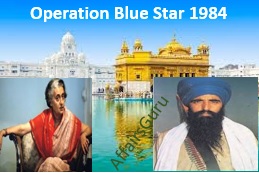Operation Blue Star PDF: 1984 Golden Temple Attack Documentary UPSC English
Operation Blue Star was an Indian military attack launched to remove militant religious leader Jarnail Sngh Bhindrawale and his followers who had sought cover in the Amritsar Harmandir Sahib Complex (Golden Temple) carried out between 1 and 8 Jun 1984.

Negotiations
In Jan 1984, India’s secret service RAW prepared a covert plan codenamed Operation Sundown involving special forces to abduct Bhindranwale from the Golden Temple complex. However, the operation never materialized due to Indira Gandhi’s rejection. It would have caused numerous casualties as collateral damage, the Golden Temple being one of the most visited sites in Punjab. Other options such as negotiations were chosen instead.
Government sent a team led by Narasimha Rao to try to convince Bhindranwale to back out but he was adamant. The negotiations failed and the law and order situation in Punjab continued to deteriorate. Indira Gandhi tried to persuade the Akalis to support her in the arrest of Bhindranwale peacefully. These talks ended up being futile.
Indira Gandhi then gave her permission to initiate Operation Blue Star on the recommendation of Army Chief Arun Shridhar Vaidya. She was apparently led to believe and had assumed that Operation Blue Star would not involve any civilian casualties.
Khalistan Demand
- Certain radical groups had already started the movement to drive Hindus out of certain areas to make way for Sikhs coming in from other states.
- New Khalistani currency was being printed and distributed.
- By May 1984, the establishment of an independent Khalistan was imminent.
- Pakistan had been supporting the militants with arms and money.
- If Khalistan declared its independence there was the risk of Pakistan recognizing the new country and sending the Pakistani Army into Indian Punjab to guarantee its security.
1st June 1984
After the negotiations with the militants failed, Indira Gandhi ordered the army to launch Operation Blue Star.
2nd June 1984
At least seven divisions of troops were deployed in villages of Punjab. By nightfall media and the press were gagged and rail, road and air services in Punjab were suspended. Foreigners and NRIs were denied entry. General Gauri Shankar was appointed as the Security Advisor to the Governor of Punjab. The water and electricity supply was cut off.
3rd June 1984
In the morning the curfew was relaxed to allow Sikh pilgrims to go inside the temple to celebrate the martyrdom day of Sikhism’s fifth guru Arjan, who martyred in the early 17th century. Around 200 young Sikhs were allowed to escape from the temple premises during this period. Most of whom were criminals and left-wing extremists (naxalites).
In the night the curfew was re-imposed with the army and para-military patrolling all of Punjab. The army sealed off all routes of ingress and exit around the temple complex.
4th June 1984
Announcements were broadcast over loudspeakers asking pilgrims inside to leave the temple. The artillery and small arms firing stopped for a while, and Gurcharan Singh Tohra, former head of SGPC, was sent to negotiate with Bhindranwale for his surrender. He was, however, unsuccessful and the firing resumed.
5th June 1984
Hotel Temple View and Brahm Boota Akhara, on the southwest fringes of the complex was attacked by BSF and CRPF.
6th June 1984
Army used Vijayanta tanks to destroy the Akal Takhat. It suffered some damage but the structure was still standing.
7th June 1984
The army entered the Akal Takht. Dead bodies of Bhindranwale, Shabeg Singh and Amrik Singh were discovered in the building. Indian army gained control over Harmandir Sahib complex.
8-10th June 1984
Army fought about four Sikhs holed up in basement of a tower. A colonel of the commandos was shot dead by an LMG burst while trying to force his way into the basement. By the afternoon of 10 June, the operation was over.
Blue Star Operation Casualities
- Sikh militants and civilians: 493 dead.
- Military: 83 killed (4 officers, 79 soldiers) and 236 wounded.
Unofficial casualty figures were higher. Bhindranwale and large number of his militants were killed.
Blue Star Operation Aftermath
- President Zail Singh visited the temple premises after the operation, while making the round, he was shot at by a sniper from one of the buildings that the army had not yet cleared. The bullet hit the arm of an army colonel accompanying the president.
- The operation also led to the assassination of Prime Minister Indira Gandhi on 31 October 1984 by two of her Sikh bodyguards as an act of vengeance, triggering the 1984 anti-Sikh riots.
- The widespread killing of Sikhs, principally in the national capital Delhi but also in other major cities in North India, led to major divisions between the Sikh community and the Indian Government. The army withdrew from Harmandir Sahib later in 1984 under pressure from Sikh demands.
- 1985 bombing of Air India Flight 182 is thought to have been a revenge action. 329 people died in this accident.
- General Arun Shridhar Vaidya, the Chief of Army Staff at the time of Operation Blue Star, was assassinated in 1986 in Pune by two Sikhs, Harjinder Singh Jinda and Sukhdev Singh Sukha. Both were sentenced to death, and hanged on 7 October 1992.
- Operation Black Thunder : In March 1986, Sikh militants again occupied and continued to use the temple compound which necessitated another police action known as Operation Black Thunder on 1 May 1986, Indian paramilitary police entered the temple and arrested 200 militants that had occupied Harmandir Sahib for more than three months. On 2 May 1986 the paramilitary police undertook a 12-hour operation to take control of Harmandir Sahib at Amritsar from several hundred militants, but almost all the major radical leaders managed to escape.
- In June 1990, the Indian government ordered the area surrounding the temple to be vacated by local residents in order to prevent militants activity around the temple.
